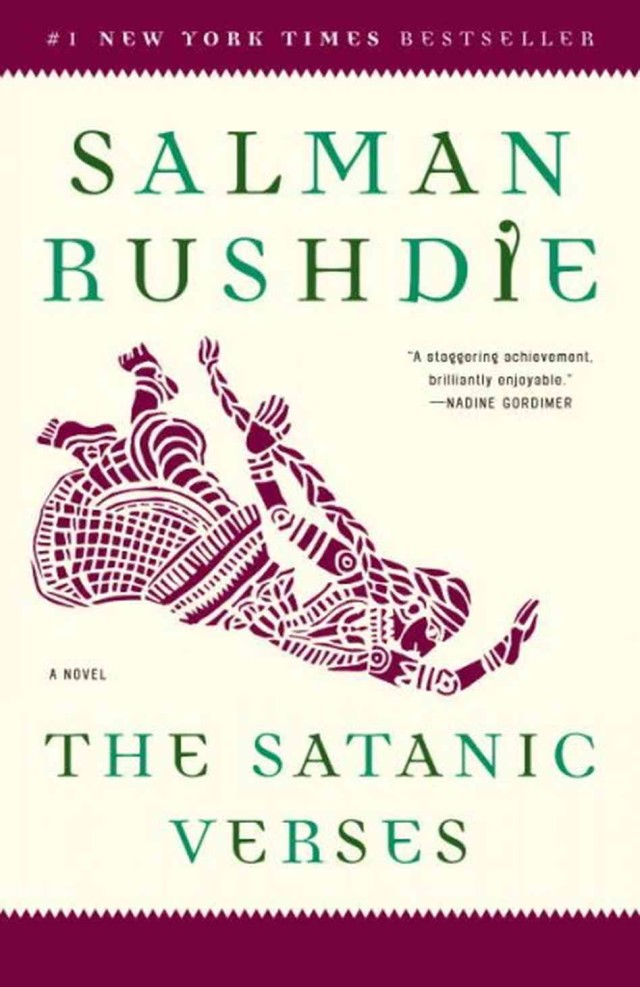Satanic Verses
by Salman Rushdie
"Contemporary Reviews" Review
The allegory surrounding Satanic Verses can be even more complicated than the allegories present in the novel. To clarify one fact or disentangle one knotted symbol, demands the research of the other hidden symbol that presses for another researching of ever deeper and tucked away histories. The most alarming and prolific exaltation found among the many reviews was the dissonance found between East and West patterns joining haphazardly with the acceptance that each are different.
Rushdie was “called impenetrable, convoluted, confused, too elitist” (Gillis, Matuz) which caused the storm in Iran as well as the dumb struck liberal cognition of the wild west. What was meant to suspend a bridge between cultures was used as an annihilation of borders causing chaos and destruction in the path marked out for the construction of discourse. A very interesting suggestion was the anti-Islamic conspiracy as noted by Paul Berman. The theory blamed British intelligence for hiring the misleading muslim Rushdie to undergo the cultural conspiracy and therefore fight Islam in another episode of invasive colonialism. Berman went on to defend his review by pointing out that “novels are not an ancient art form in Iran; the Qur’an is read literally, not in context” (Berman). What this means is that the entire fabled conspiracy was the subject of a huge misunderstanding lead by matters of unyielding interpretations. Berman defends Rushdie’s anti-colonialism and believes the political conspiracy was just as fantastical as Rushdie’s imaginative work in Satanic Verses. As far as literal accuracies, muslims were not able to see the novel in context because the new, the intermingling, the hybridity is a product of the intruding imperialism that oppose the very morality the nation of Islam is trying to protect. Not entirely flawless, but entirely void of new enlightening thought that would destroy the laws of a faith. A less common narrative with yet a pervasive element of contradiction came from Magill Book Review. The Vedic literature of India, pashyanti, was referenced and likened to Rushdie’s revelatory work, claiming that Satanic Verses is a form of “aesthetic rapture”(Magill). This leads one to believe that Satanic Verses has much more within it, than the eye can see, the reader may have to allow themselves to be lifted into the very angelic realms Rushdie contradicts in praxis. The review also pointed to the language being distinctly used as a practice of affirmation that takes pride in previously used contemptuous language, yet another expansion of consciousness as raised by the foreigner in new subjective territories. An embrace as well as objection came from a NYT article by A.G. Mojtabai. Mojtabai who praised Rushdie’s “narrative energy and wealth of invention”, but just as much thought the work “as sustained exploration of human condition flies apart into delirium” (Mojtabai). So what is completely fascinating is also completely dulling because of its velocity.
All in all, one of the most important features to synthesize of the reviews was the fact that all of the fury and craze surrounding the books controversy have done nothing to bring humanity closer to educating our ignorance. Each side seems to annihilate the other but without real evidence or tolerance for the others point of view. A more recent review analyzing migration and the grotesque in Satanic Verses does just that, but from a scholarly approach that may never fall into the hands of the masses. From Katharina Donn’s analysis of Satanic Verses the novel represents a “discourse of fundamentalism” (Donn) from a postcolonial migrant experience. In this way Satanic Verses presents a leitmotif of alterity; the otherness the foreigner experiences in new land as well as the otherness that comes by assimilation and the metamorphosis that transpires through the process. The question that still persists, what have we learned from these divides and how do we bridge the gap?
Works Cited
Berman, Paul. “Shame.” New Republic 203.15 (1990): 31. MAS Ultra – School Edition. Web. 4 Nov. 2014
Donn, Katharina. “Migration And The Grotesque In Salman Rushdie’s The Satanic Verses.” Anglia-Zeitschrift Für Englische Philologie 131.1 (2013): 100-120. Humanities International Complete. Web. 4 Nov. 2014
Ed. Roger Matuz and Mary K. Gillis. India Today. “Salman Rushdie: Satanic Storm.” India Today 14.3 (15 Mar. 1989): 14-24. Rpt. in Contemporary Literary Criticism. Vol. 55. Detroit: Gale Research, 1989. Literature Resource Center. Web. 4 Nov. 2014.
Magill Book Reviews “The Satanic Verses.” (1990): MAS Ultra – School Edition. Web. 4 Nov. 2014
Mojtabai, A. G. “Magical Mystery Pilgrimage,” New York Times Book Review Jan. 29 1989, pp. 3, 37. Web. 4 Nov. 2014
Discussion Questions
What irony did you find in the controversy surrounding Satanic Verses?
How does the controversy surrounding Satanic Verses imply the study of intercultural communication?
What underlying identities do you find, if any, between Gibreel Farishta and Saladin Chamcha?
Where do you see themes of liberalism and/or totalitarianism?
What hidden meaning did you find behind the flooded use of allegory?
Considering Gibreel and Saladin are actors, what is the importance of this in defining their characters?
Does anything stand out as being particularly blasphemous? Or is it all simply fictitious?
Why does Rushdie change the names of those which reference the Qur’an? What does he ultimately achieve by doing so?
Creative Adaptations
You’re Dead! – Austin Amsler
For this adaptation of Salman Rushdie’s The Satanic Verses, I utilized the particular scene in which Saladin and Gibreel fall from the sky after being subject to a terrorist attack on a plane. As they descend and subsequently start to take on their respective characteristics of a devil and an angel, I reinterpreted their transformations using my modular synthesizer to compose fields of sound to represent the major parts of the scene. I then combined them all into my main audio production program to create a retelling using only audio.
